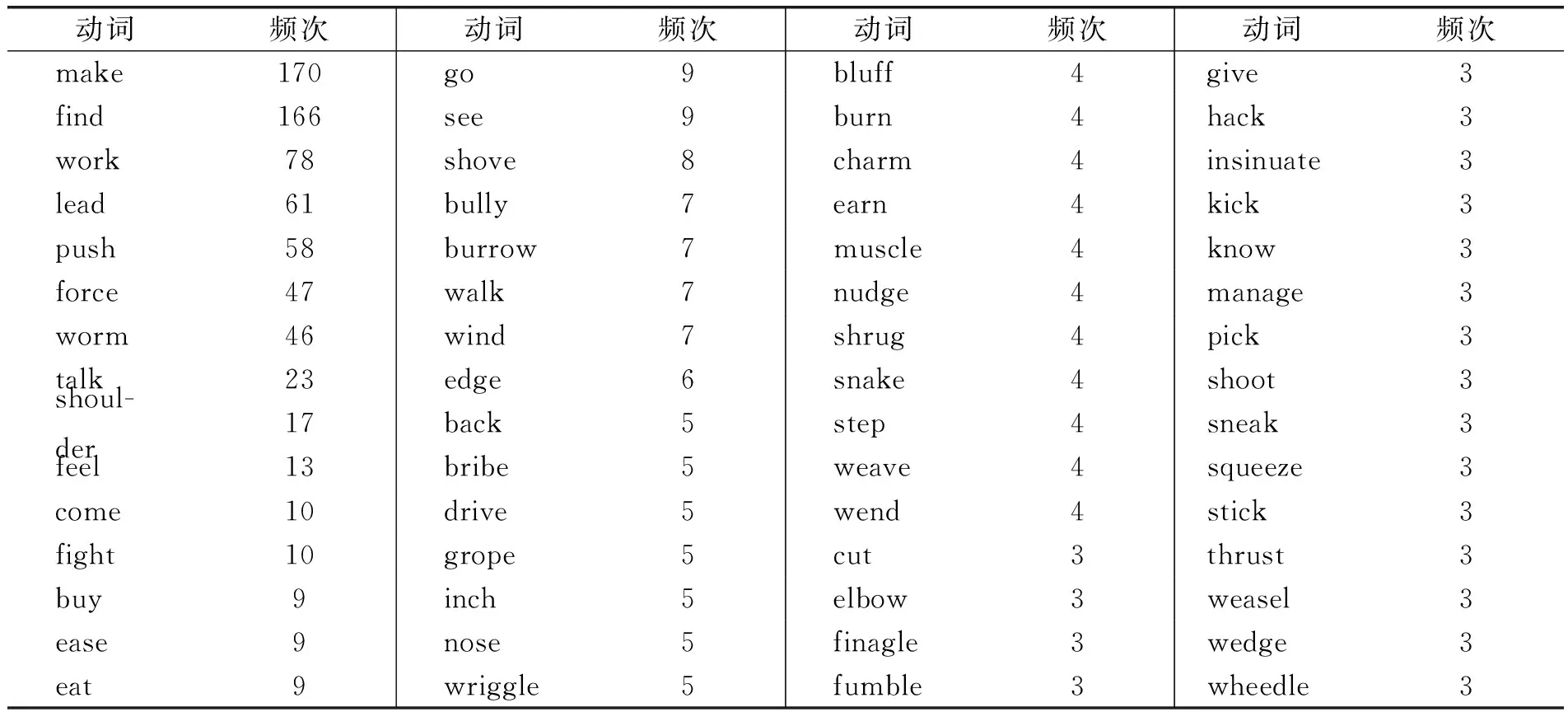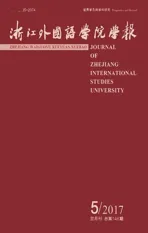Way into的动词搭配及其对翻译的启示——基于英语母语及汉英平行语料库的分析
2017-11-06冯全功
冯全功
(浙江大学 外国语言文化与国际交流学院,浙江 杭州 310058)
Wayinto的动词搭配及其对翻译的启示——基于英语母语及汉英平行语料库的分析
冯全功
(浙江大学 外国语言文化与国际交流学院,浙江 杭州 310058)
对“美国当代英语语料库”(小说子库)中与way into搭配的动词的检索发现,在1160条有效语料中,共有254个不同的动词与way into构成搭配,呈现出多样化的特征,其中概念认知型搭配与修辞认知型搭配的数量基本相当。英语写作或汉英翻译时,根据具体的语境选择合适的动词与way into进行搭配,有助于提高原创(翻译)英语文本的质量。
way into;搭配;文学性;概念认知;修辞认知
一、引言
近读葛浩文(Howard Goldblatt)英译的几部莫言小说,包括《檀香刑》《红高粱》《丰乳肥臀》《生死疲劳》等,对译者高超的英语应用能力感触颇深。译本中的一个语言现象也引起了笔者的注意,即葛浩文用了很多动词与way into进行搭配,以使文本生动活泼,富有表现力。笔者在此聊举“葛浩文英译小说汉英平行语料库”(A Parallel Corpus of the English Translations of Chinese Novels by Howard Goldblatt)①中的几例:
(1)原文:……一个身穿绿色制服的小伙子……气喘吁吁地进了我们的院子。
译文:... in a green uniform came puffing his way into our compound...
(2)原文:他们像两个找不到爹娘的孩子一样在车站广场上挤着。
译文:... they elbowed their way into the square...
(3)原文:毛驴高亢的叫声,钻进高粱地里来……
译文:The braying donkey threaded its way into the sorghum field...
(4)原文:余一尺从市府大院的阴沟里钻进了市府大院。
译文:Yu Yichi tunneled his way into the City Hall compound...
(5)原文:蝗虫啮咬万物的可怕声音,渗透到人的骨髓里。
译文:The sickening gnawing sound ate its way into the marrow of her bones.
(6)原文:这个富有特色的笑容,深刻在我们的脑海里。
译文:That singular smile burned its way into our heads.
(7)原文:他感到一阵奇痛钻进了脑子……
译文:A sharp pain drilled its way into his brain...
(8)原文:果然是学过戏的女人,知道用什么方子征服人心。
译文:... she knew exactly how to worm her way into people’s hearts.
例(1)—(8)中的搭配都十分地道、形象,那么英语中还有哪些动词可以与way into进行搭配?高频使用的动词有哪些?这些与way into搭配的动词呈现出什么样的特征,是否在隐喻层面进行运作?关于英语动词与way into搭配的研究对翻译又有什么启示?笔者检索了“美国当代英语语料库”(Corpus of Contemporary American English)②,发现含有way into的语料共有5121条,数量比较多,因此只选择小说子库中的1416条语料加以分析。
二、英语动词与way into的搭配分析
进一步研究后发现,1416条语料中,并非所有的way into都直接与相关动词进行搭配,如“There’d only been one other car on the road the whole way into town...”“... he will come clumping through the main hall and our bright kitchen on his way into the back hallway...”等,因此必须对之进行人工整理。经整理,共得到有效语料1160条。个别语料存在两个并列的动词同时与way into搭配的情况,如“All four of them tumbled and pushed their way into the battered van...”遇到此种情况时,笔者只选择与way into临近的动词(如上例中的push),较远的则不再计入统计数据(如上例中的tumble)。在这1160条有效语料中,共有254个不同的动词与way into形成搭配,平均4.6条语料出现一个不同的动词(不计形态变化),这说明与way into构成搭配的动词具有多样化特征。其中,出现10次及以上的高频搭配词有make、 find、work、lead、push、force、worm、talk、shoulder、feel、come、fight,占总数的4.7%;出现5次及以上10次以下的有buy、ease、eat、go、see、shove、bully、burrow、walk、wind、edge、back、bribe、drive、grope、inch、nose、wriggle,占总数的7.1%。所选语料中,与way into搭配出现频次3次及以上的高频动词如表1所示:

表1 高频动词及其出现频次
此外,254个动词中,出现频次为2次的动词有44个,而如swindle、whistle、trudge等150个动词仅出现了1次,这些动词与way into的搭配也都很生动、形象,例如:
(9)... during the first four months of each pregnancy,she would have vomited her way into the hospital with every child,and the nausea never really went away until...
(10)After a remarkably colorful Saturday,I have somehow zombied my way into Sunday.
例(9)中的way用的是概念意义,即语义上指涉的是真实的道路,例(10)中的way用的是隐喻意义,即未涉及真实的道路,只是把消磨时间比喻成了(像僵尸般)走路。我们把诸如例(9)中的搭配称为概念认知型搭配,把诸如例(10)中的搭配称为修辞认知型搭配。概念认知是一种把握世界的普遍方式,指向事物的共性,概念组合体现了事物的逻辑关系与世界的现成秩序,支持概念认知的是逻辑语境;修辞认知是一种主体化的认知行为,进入修辞认知的概念往往偏离了事物的语义规定,能激起具体生动的感性经验,支持修辞认知的是审美语境[1]23。在文学世界里,修辞认知的审美潜力往往大于概念认知,更为作家所青睐。隐喻是最典型的修辞认知家族成员之一,也可视为修辞认知的原型。针对way into的动词搭配,区分其到底属于概念认知型搭配还是修辞认知型搭配首先是判断way是否指涉真实的道路,而这并不完全取决于与way into搭配的动词,还要看构式整体,尤其是into后面的词汇:如果属于概念认知的范畴,way into后面的名词往往是具体的地点;而如果属于修辞认知的范畴,way into后面的名词往往是抽象的地点,或者根本与地点无关。其次是看动词本身的运用在上下文语境中是否偏离了其通常的语义规定。如例(10)中的搭配既没有涉及真实的道路,zombie的使用也偏离了其语义规定,所以属于典型的修辞认知型搭配。1160条有效语料中,概念认知型搭配与修辞认知型搭配各占半壁江山(前者为587例,后者为573例),并且动词搭配都比较多样化,相比而言,后者更具表现力,也更能体现作者的个性化语言特征,尤其是那些新鲜的搭配。
(一)概念认知型搭配
概念认知型搭配中的way基本上都指涉真实的道路,或者整体上与走或移动的语义相关。通过语料分析,笔者发现与way into构成概念认知型搭配的动词具有一些典型的特征,比如通常与人的肢体或肢体动作相关,能给人一种较强的画面感,例如:
(11)Golanth had shouldered his way into the thick forest...
(12)Henry was trying to nose his way into a desk...
(13)He glanced to his right,where Kevin had muscled his way into the front row.
(14)... as they nudge their way into the crowd of men at the base of the footpath.
(15)I was shrugging my way into the arms of my insulated overall...
(16)We elbowed our way into groups.
(17)... kicking his way into a burning building of trapped people...
(18)... the squirrels gnawing their way into the attic...
(19)A woman being turned inside out,a baby pushing,clawing its way into the world...
(20)... like he’s trying to chew his way into the Humvee.
例(11)—(20)中与way into构成概念认知型搭配的动词的出现频次都不低于2次。1160条有效语料中,有些与way into构成概念认知型搭配的动词虽然不直接与人的肢体或肢体动作相关,但是是由人的动作或行为引起,例如:
(21)It’s noon,and people are pushing their way into the cafe.
(22)The crowd was thick in front of him,men still forcing their way into the warehouse.
(23)They’re looking up as I feel my way into Maude’s bedroom...
(24)The first unit will fight their way into the cave and kill the child...
(25)Ruthie eased her way into the living room.
(26)He shoves his way into a corner,pissing off everyone on the way...
(27)He burrows his way into the crowd.
(28)The following day,he was going to try to edge his way into the operating room...
(29)The woman would think he’d groped his way into the bathroom.
(30)Annoyed,he inched his way into a crevasse...
(31)She pushed and wriggled her way into her own yard,crawling on her...
(32)After dinner,they wended their way into the living room...
(33)As I fumbled my way into bed later that night...
(34)... a lone gunman... trying to shoot his way into the U. S. Capitol...
(35)... people sneaking their way into this country through a side door...
(36)... the bigger,fatter one fought and squeezed his way into the narrow culvert.
(37)... I hear him splashing his way into the stream.
(38)Sir,the wild dogs have dug their way into the food...
(39)Maggie snapped as she sloshed her way into Bert’s house.
例(21)—(39)中与way into构成概念认知型搭配的动词的出现频次也都不低于2次,它们虽不是由身体的某一具体部位发出,但仍具有较强的动作性,它们的使用为译本增色不少。此外,与say相关的动词也常与way into搭配,例如:
(40)... he’s at heart a friendly sort,the type who could talk his way into homes.
(41)... mansion in all of Serenity that Mother had never dared try to wheedle her way into...
(42)Two men dragging a third... screamed their way into the emergency room.
(43)A few days later,when I begged my way into the conference as a science writer...
(44)I saw Jack Nicholson grouse his way into her bed.
(45)... We’re laughin’ and jokin’ our way into prison.
(46)He groaned his way into the open air...
(47)Ms. Oglethorpe grunted her ponderous way into the office.
例(40)—(47)中的动词scream、grouse等都与say相关,与其属于同一语义场(semantic field)。
(二)修辞认知型搭配
修辞认知型搭配中的way并不指涉真实的道路,脱离了其表层的语义规定,搭配往往具有很强的陌生化效果,体现了文学语言的艺术性,例如:
(48)I would have to force my way into the conversation...
(49)... the phrase nudges its way into my head...
(50)She only likes the songs that chew their way into her brain like a worm.
(51)Frankie and Lucia had to fight their way into the New York City dance world.
(52)... she and Weeds had shouldered their way into a domestic disaster.
(53)... what was obvious burrowed its way into his consciousness.
笔者发现,部分与way into构成修辞认知型搭配的动词与say相关,例如:
(54)... she’d managed to talk her way into a job atPeopleLikeUs...
(55)Spelding,who had been trying to wheedle his way into a date for weeks...
(56)... she spoke her way into Amay’s heart.
(57)Clyde schmoozes his way into easy sales,gets the clients...
(58)... and now I have lied my way into having to leave the house altogether...
例(54)—(58)中,a job、a date、Amay’s heart、easy sales、having to leave the house altogether指涉的都不是具体的地点。值得一提的是,一些动词既可与way into构成概念认知型搭配,也可以与之构成修辞认知型搭配,如例(11)与(52)中的shoulder,例(14)与(49)中的nudge,例(20)与(50)中的chew,例(22)与(48)中的force,例(24)与(51)中的fight,例(27)与例(53)中的burrow,例(40)与(54)中的talk,例(41)与(55)中的wheedle等。
在一些典型的修辞认知型搭配中,一些动词与way into构成了“反常”搭配,它们并不涉及真实的道路,例如:
(59)I could use it to buy my way into the good graces of the bloody pirate Morbruzzo...
(60)While the seagulls eat fish,water slowly eats its way into the flesh of the stone.
(61)Sonja was always bullying her way into the center of things...
(62)They bribed their way into positions of power.
(63)... dimpled darling who could charm her way into your heart...
(64)... the Columbia grad quickly earned her way into his good graces.
(65)Cynthia had finagled her way into being the escort for a visiting artist...
(66)Having fucked my way into this job...
(67)I’m now going to write my way into history.
(68)Lissy browsed through or just read part of the way into most books...
(69)I’d make an effort to imagine my way into her life...
(70)Would-be authors seeking to gain their way into our pages by means of such flattery...
在一般情况下,即使没有上下文语境依托,“反常”搭配的类型也比较容易识别。然而,如果into后面跟的是地点的话,有些看似“反常”的搭配也有可能属于概念认识的范畴,如以下两例:
(71)... the watch he used to deceive his way into the house.
(72)They are genetically engineered to think their way into an enemy’s lair...
在一些修辞认知型搭配中,其隐喻义是从相关的名词转化而来的,如例(73)“像楔子一样钻入我的生活”,例(75)“像线一样穿入森林”等。
(73)When she wedged her way into my life...
(74)This notion wormed its way into her head and stayed there.
(75)... on one of these forestry roads that thread their way into woods...
(76)The bird shit is snaking its way into the crack between the windshield...
(77)... my father was sifting his way into them on a walkthrough count of the lambs.
(78)Her cheek tingled as... poison-grub leaves filtered their way into her blood.
例(73)和(74)还具有双重修辞认知的性质,首先是动词本身,其次是way的喻指,这使得话语表达更加生动、形象。
笔者在此再举几例:
(79)... intoxication seeped its way into every insecure crack.
(80)... she golfed her way into the heart of every well-to-do male member...
(81)... and angling his way into the gentry with his artful real-estate ventures.
(82)This exchange took place as Janice downshifted her way into a small city...
那么,为何会有如此多的动词可以与way into形成搭配?笔者认为,构式语法可为其提供有效的解释,尤其从历时角度分析,way构式的演变“由初期含有具体句且句数少,演变为含有大量抽象句,并对整个语言系统进行了微调和重组”[2]5。其中,概念认知型搭配可视为way的初期构式(搭配动词主要包括简单位移动词、路径创建/清障动词及拥有义动词),修辞认知型搭配则主要为演变后的构式(构式扩容或语法化的识解方式主要为隐喻)。Way构式的能产性很强,很多“新”动词能与之形成搭配或参与构式,而隐喻识解(修辞认知)则是这种多样化的根本原因之一。
三、Way into动词搭配对翻译的启示
对“葛浩文英译小说汉英平行语料库”的研究发现,与way into搭配的动词呈现多样化的特征,那么其他中国文学作品的翻译中是否也存在类似现象呢?笔者检索了绍兴文理学院创建的“中国汉英平行语料大世界”(Pool of Bilingual Parallel Corpora of Chinese Classics)③中的四大名著汉英平行语料库,剔除个别不符合要求的语料,发现四大名著英译本中(各自对应一个英语译本)共有有效语料46条,与way into搭配的动词共计15个,频次从高到低依次为:make、force、worm、find、fight、lead、smash、booze、bribe、elbow、grope、know、work、sneak、wind。我们先看几个属于概念认知型搭配的例子:
(83)原文:……曲径接天台之路。
译文:The winding path made its way into a fairy hill.
(84)原文:……果然黑地里摸入荣府,趁掩门时钻入穿堂。
译文:... he groped his way into the Rong-guo mansion...
(85)原文:说着,便起身扶着宝玉的肩,带领众人齐往园中来。
译文:She got up and,leaning on Bao-yu’s shoulder,led the way into the Garden.
(86)原文:只打到通明殿里,灵霄殿外。
译文:He fought his way into the Hall of Universal Brightness...
(87)原文:……娇声问道:“是甚么人,擅入我寡妇之门?”
译文:“Who has forced his way into this widow’s house of mine?”
(88)原文:那八戒与土地,依言攻破洞门不题。
译文:... Pig and the local god smashing their way into the cave...
例(83)—(88)中动词与way into的搭配都十分地道,也非常切合具体的语境,一定程度上体现了译者的语言功底。Way into的概念认知型搭配涉及真实的位置移动,从一个地方到另一个地方,到达的方式是译者决定使用哪一个(类)动词的重要依据之一。换言之,具体的文本语境是译者选取哪一个(类)动词与way into进行搭配的决定性因素,同时也是衡量动词搭配是否精确的重要标准。
然后,我们再来看几个属于修辞认知型搭配的例子:
(89)原文:……膏药从不拿进屋里来的。
译文:Never has medicine of any kind found its way into this room.
(90)原文:那些小些的,都钻进戏房里瞧热闹儿去了。
译文:The younger ones wormed their way into the green-room...
(91)原文:那些书吏衙役,都是花了钱买着粮道的衙门……
译文:Those clerks and runners all bribed their way into this yamen.
(92)原文:不喝也好,强如象你哥哥喝出乱子来。
译文:Better than your cousin,anyway,forever boozing his way into trouble.
(93)原文:汝乃织席编屦之夫,今辄占据大郡,与诸侯同列……
译文:You have been smart enough to... elbow your way into the ranks of the nobles.
(94)原文:……输货权门,窃盗鼎司,倾覆重器。
译文:... who contrived to sneak his way into considerable office...
例(89)—(94)译文中的修辞认知型搭配实现了从概念认知(原文)到修辞认知(译文)的转换,对原文的文学性(陌生化效果)具有强化作用。其中,之所以把例(89)列入修辞认知的范畴,是因为“medicine”本身是不会“found its way into this room”的,属于无灵主语与有灵动词的搭配。这里译者把“膏药”拟人化了,或者说把原文的概念认知转换成了译文的修辞认知,从而强化了原文的文学性。例(90)中的“wormed”本身具有修辞认知(隐喻)的意味,有点类似于死喻,但依然能引起读者的意象化联想。例(91)—(94)的共同点主要在于其“反常”搭配(尤其是into后面的名词),类似于认知语言学中的容器隐喻(如例(92)into trouble的搭配就是把trouble视为能够进出的容器),因此同样取得了很好的陌生化效果,同时,bribe、booze等动词的精准使用对刻画人物性格也有一定的助益。
综上可知,在进行文学翻译(汉译英)时,不管是概念认知型搭配还是修辞认知型搭配,译者选择与way into搭配的动词时都要做到切合具体的语境,尽量使之精准化。那么,与原创英语文学作品中way into的动词搭配相比,中国文学作品英译本中的动词搭配是否同样多样化呢?是否可以假设,后者动词搭配多样化程度不如前者呢?笔者认为,要想解答这个问题,首先要选择两个库容相似的语料库(最好收录相近数目的作品),然后再对其中的有效语料进行对比分析。由于条件所限,这个问题本研究未有涉及。
四、结语
笔者之所以研究动词与way into的搭配,主要在于阅读与教学过程中本能地感知到其丰富的表现形式,以及强大的表现力,而本研究则在很大程度上印证了这种“直觉”。基于语料库(尤其是“美国当代英语语料库”)关于动词与way into搭配的研究,剖析了概念认知型搭配和修辞认知型搭配的一些特征,对英语写作、汉英翻译以及翻译教学等都有一定启示。不管是英语写作还是汉英翻译,选择与way into搭配的动词时,都要切合具体的语境,遵循“语义和谐律”[3]的原则,努力实现搭配的精准化与形象化,以便更好地提升原创(翻译)英语文本的质量。当然,本研究还存在一些局限,如并没有对英语原创文学作品与中国文学作品英译中way into的动词搭配进行定量比较,再如仅研究了小说这一文体中way into的动词搭配等。这些问题需要未来作进一步的探讨。
注释:
①该语料库为燕山大学侯羽老师所建,文中使用的葛译语料系笔者委托其代为检索。
②网址为http://corpus. byu. edu/coca/,检索日期为2016-10-22。
③网址为http://corpus. usx. edu. cn/index. asp,检索日期为2016-10-26。
[1]谭学纯,朱玲,肖莉. 修辞认知和语用环境[M]. 福州:海峡文艺出版社,2006.
[2]张建理,徐银. WAY构式的语法化历程探讨[J]. 外语教学,2013(6):1-6.
[3]陆俭明. 修辞的基础——语义和谐律[J]. 当代修辞学,2010(1):13-20.
ACorpus-basedStudyontheCollocationbetweenEnglishVerbsandWayintoandtheLightShedonChinese-EnglishTranslation
FENGQuangong
(SchoolofInternationalStudies,ZhejiangUniversity,Hangzhou310058,China)
This paper finds that among 1160 cases collected from the fiction section of Contemporary American English Corpus there are 254 different verbs used to collocate with way into. Moreover,cases belonging to the category of conceptual cognition are roughly equivalent to those belonging to rhetorical cognition,and members of each category are equally diversified. These findings can help the English author or Chinese-English translator make the best choice when using this knid of collocation so as to enhance the literariness and readability of their original or translated works.
way into;collocation;literariness;conceptual cognition;rhetorical cognition
H315.9
A
2095-2074(2017)05-0076-07
2017-07-11
国家社会科学基金青年项目(16CYY008);教育部人文社会科学研究青年基金项目(15YJC740015)
冯全功(1984-),男,河南泌阳人,浙江大学外国语言文化与国际交流学院讲师,博士。
